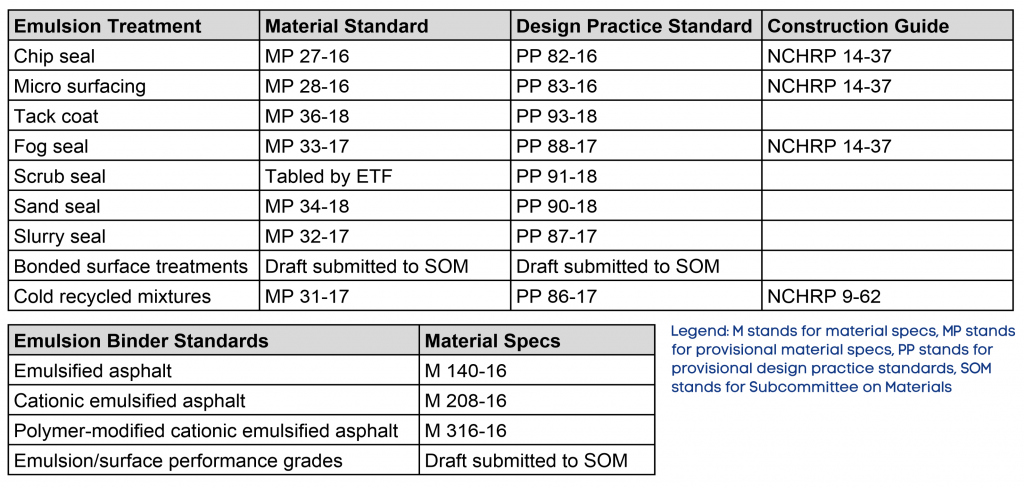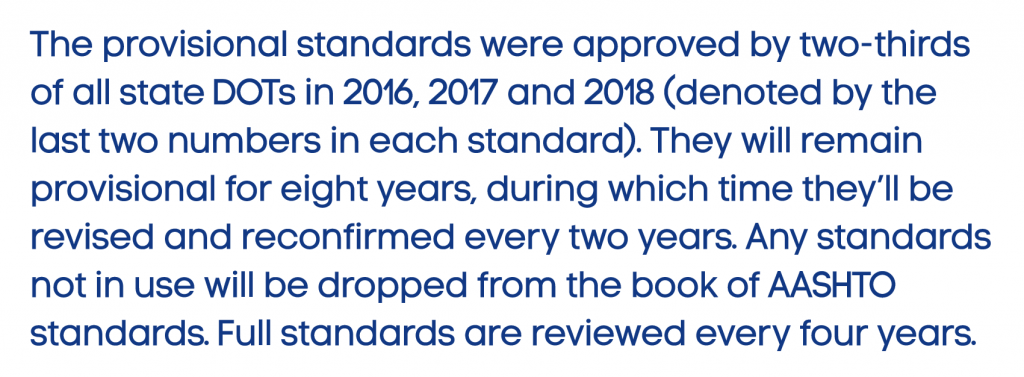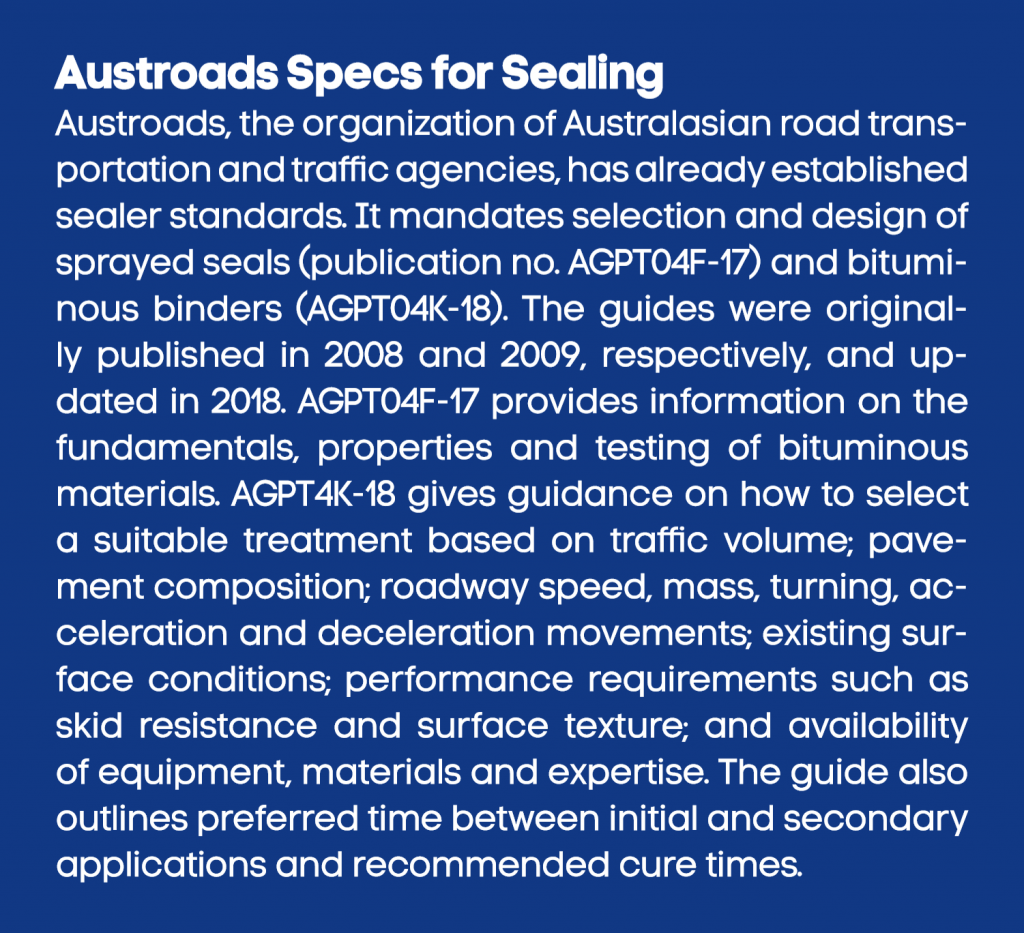New AASHTO Pavement Preservation Standards, Explained
BY AsphaltPro Staff

What you need to know about new material standards, design standards and construction guides from AASHTO’s Emulsion Task Force. What impact will the specifications have on pavement preservation treatments, including chip seal, micro surfacing and fog seal, as well as tack coats and cold recycled mixtures?
The pavement preservation and emulsion treatment standards recently published by the American Association of State Highway and Transportation Officials (AASHTO) have been a long time coming.
With the 2012 passage of the Moving Ahead for Progress in the 21st Century (MAP-21), state DOTs could begin to use federal funds for pavement preservation. That legislation, along with the passage of other maintenance-related legislation over the past few decades, has made the necessity of national standards for pavement preservation treatments increasingly apparent.
That’s why the Emulsion Task Force (ETF) was established in 2008, with support from the Federal Highway Administration, FP2 Inc., the National Center for Pavement Preservation, International Slurry Surfacing Association, Asphalt Emulsion Manufacturers Association and Asphalt Recycling and Reclaiming Association.
“In the past, emulsions have not been given as much importance and technical support as hot-mix asphalt,” reads the task force’s website. As such, emulsion technology lagged behind the mainstream hot-mix asphalt technological improvements made in the early ‘90s through the SHRP (Strategic Highway Research Program), said ETF Co-Chair Colin Franco. “It is well known that for a technology to be widely accepted by state and local agencies, national standards for that technology must be developed and made available.”

During the past couple of years, the task force has begun to draft the pavement preservation standards it has developed over the past 10 years for incorporation into AASHTO standards. AASHTO standards for any given material or treatment normally require material standards, material test methods, material design practices, and construction guides.
See the chart accompanying this story to see the treatments and their corresponding standards.

The goal is that all of the standards for each treatment come together to give agencies and contractors “a high level of confidence that they will have a quality job,” said Larry Tomkins, chair of the ETF’s Marketing Subcommittee and vice president of sales and marketing for the southeast region of Ergon Asphalt and Emulsions Inc., Jackson, Mississippi. “That’s the whole objective of what we’re doing. We want to raise the bar and increase the quality of work that’s going on in the pavement maintenance world.”
Agencies Adapt and Adopt
“These treatments are being used all over the country, but there was no national standard,” said Jim Moulthrop, executive director of FP2 Inc., and co-chair of the ETF Subcommittee on Design Group: Mixtures. “A lot of agencies already have their own specifications for many of these treatments.”
Moulthrop estimates that most agencies already have their own specifications for more common treatments, such as chip seals, cold in-place recycling, micro surfacing, slurry seal and fog seals. Where the standards put forth by the ETF are more eagerly adopted is for treatments that are newer or less familiar to various agencies, such as scrub seals and sand seals.
Although the agencies aren’t required to adopt the national standards, Franco hopes that states will see the benefits the new standards could bring. The AASHTO standards are also useful as a reference for local agencies, who can follow state DOT specs or the AASHTO standards.
“We expect adoption of these standards to take some time,” Franco said. “Although they are two years old, two years in our industry is still very new.”
To get the word out that the standards are done, Tomkins said the task force plans to present the new standards at regional and state DOT meetings and AASHTO meetings. In a recent survey, around 30 percent of state DOTs said they intend to follow the AASHTO standards set forth for these preservation treatments. Some agencies (between zero and 12 percent, depending on the treatment) have already begun to use the new standards from AASHTO.
One of the most significant challenges to adoption of the new standards by various agencies is that many DOTs already have specs for some of the treatments.
“If they’ve been using a spec for years, it’s always a challenge to encourage change,” Tomkins said. “We have to show them that there might be something better out there that could give their projects a better chance of success.”
Benefits To Be Had
Tomkins said some of the chief benefits of the new national standards is that they are formalized, up-to-date and have been thoroughly vetted.
“They’ve been through numerous committees, they’ve been voted on by all the DOTs, they’ve been scrutinize and commented on,” he said. “They’re vetted and they’re up-to-date.”

He also sees it as a matter of educating the next generation of DOT staff and preservation crews.
“In the past, agency personnel had a wealth of experience that they didn’t need much direction,” Tomkins said. “They knew what to do. But those people are retiring and that institutional knowledge is gone. These specs help close the knowledge gap on some of these processes.”
Franco said that the national standards also establish a consistent baseline for comparison, as well as further technology improvements, that isn’t possible if every agency has its own spec. The standards can also help agencies establish quality incentives and disincentives for these types of jobs.
National standards for these pavement preservation treatments can also streamline processes for contractors and reduce the number of emulsion grades being manufactured.
Franco, who is also Associate Chief Engineer at Rhode Island Department of Transportation, gave an example of the DOTs of Massachusetts, New Hampshire, Connecticut, Rhode Island and Maine. Each may have its own chip seal spec, requiring a particular type of liquid. In that case, regional contractors may have five different liquid grades in stock, which can be a production, storage and logistics issue.
“The national standards make things consistent so that contractor in the northeast may only need to have one or maybe two grades of liquid available for a particular treatment type,” Franco said.
For contractors, Tomkins sees the new standards offering a clearer outline of what they can do to maximize quality.
“I don’t think the material or design practice specs will directly affect them,” Tomkins said, “though they may indirectly see a higher level of confidence in the materials they use and the process they’re using.”
However, Tomkins sees the forthcoming construction guides as a valuable resource.
“You can have the best materials in the world that meet spec and the design works, but if it isn’t applied following best practices and it isn’t tested right, the chances of having a quality project go down,” Tomkins said.
The construction guides will also be helpful for inspectors, offering them guidance on how often to pull samples and how to check the job quality.
“It almost comes full circle,” Tomkins said, “from the agency developing the design and specifications to the contractor applying the process and then back to the agency to ensure the specifications were followed.”
 Collaborate on Construction Guidelines
Collaborate on Construction Guidelines
Although the task force is not directly responsible for preparing the construction guides, the idea to put them together was born from within the task force, Moulthrop said.
The task force submitted a request to the National Cooperative Highway Research Program (NCHRP), which is funded by AASHTO, to produce a document outlining best practices for each of the preservation treatments it had developed material and design practice standards. In 2016, AASHTO voted to fund construction guides for chip seal, micro surfacing and fog seal applications, NCHRP 14-37, for which Moulthrop is one of the authors.
Franco hopes construction guides for the remaining treatments will be completed within the next year.
The guidelines would help agencies and contractors utilize best practice guidelines for any given preservation treatment and could be used to help demystify issues that may be decreasing the performance or lifespan of their preservation treatments, Moulthrop said. The construction guidelines also include commentary outlining exceptions to rules or giving additional detail on the advice outlined in the guide.
For instance, it recommends agencies in colder climates who typically use a PG 64-22 base binder for emulsions may consider using softer grades, such as PG 58-28. Another example from the guide is to consider using additional water when micro surfacing if the placement conditions are very warm, as long as the extra water does not affect the consistency of the mixture.
Franco said that for contractors who have already integrated quality control into their operations and are performing pavement preservation treatments properly, the information outlined in the construction guides may mirror the best practices they already use in the field.
“For contractors who aren’t using best practices in the field, the standards hold them accountable for doing the work well and helps the agency ensure each job is done correctly,” Franco said.
But before any of these standards could even begin to affect the way pavement maintenance contractors operate, the task force has its work cut out for them to get agencies to adopt the range of standards: material, design practice and construction guides.
“We really need to show them the value of the new specs, compared to what they’ve been using for 20 years,” Tomkins said. “It’s our job to make them comfortable with the new spec and help them understand why it is important to them and how it could improve their projects.”
